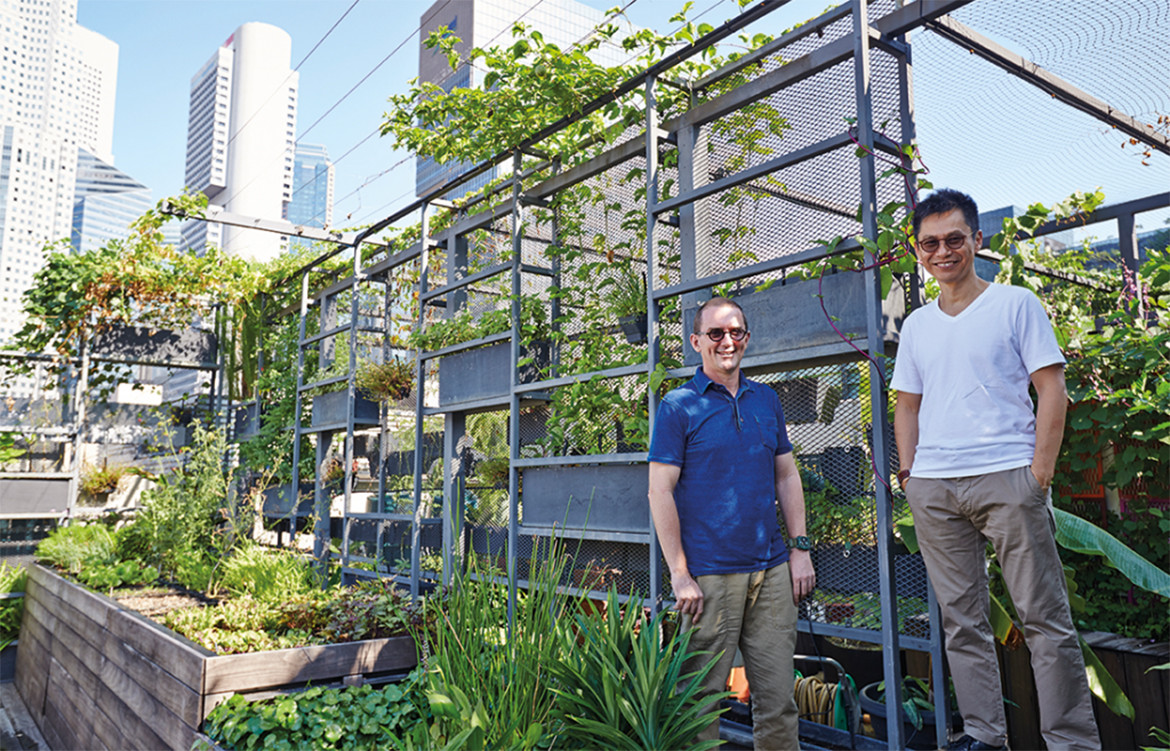In case you weren’t aware, on the rooftop of the WOHA studio on Hong Kong Street there’s a unique experiment going on. WOHA founders Wong Mun Summ and Richard Hassell have transformed what once was the sole domain of air-conditioning compressors into a productive rooftop garden.
They’ve planted approximately 100 species of fruits and vegetables, and on my visit I’m shown water chestnut, rocket, tomatoes, lettuce, pandan leaves, lime, chilli, passionfruit, pumpkin, cucumber, basil, lemongrass, grapes, strawberries, mint, kang kong, sweet potato, laksa leaves, pomegranate, bananas, guava, long beans, bay leaves and ginger, as well as tilapia fish that make contributions to a closed-loop water fertilisation, filtration and circulation system.
“It doesn’t feed all the people in the office, but it’s enough to show that it can be done,” says Wong Mun Summ, who explains that a core team of ‘farmers’ from the studio tend to the garden on a daily and weekly basis. Pesticides are avoided and, at the moment, insects are doing some damage. But Mun Summ hopes that with more time, birds will discover the garden and a self-sustaining ecosystem will develop.
Looking across to the mute and baking roof terraces of the neighbouring buildings, a familiar train of thought unfolds, surprise becomes dismay that more people don’t try this. It’s an impression I’ve felt upon visiting many of WOHA’s projects – from Oasia Hotel Downtown with its living facade, open urban rooms (just waiting for the skybridge connections that the future may bring), and astounding green plot ratio exceeding 1000 per cent (with landscape architect Sitetectonix); to Skyville @ Dawson with the amenity of lengthy landscaped terraces serving clusters of floors throughout the height of the towers (with landscape architect ICN Design International), and of course PARKROYAL on Pickering, which has become a poster project in Singapore for garden-infused architecture (with landscape architect Tierra Design).
I put it to Mun Summ that WOHA’s work consistently promotes the normalisation of what seem at first to be radical concepts. “We tend not to realise it but yes, our work can be quite radical,” he says.
“We do things in our stride,” he adds, “but it’s when we start doing calculations on the kinds of percentages we can achieve in terms of green replacement, for example, that we start to see our buildings as being radically different to others. That’s when we realise it’s possible for the city to transform.”
WOHA’s work is a powerful form of proto-typology, as the architects suggest in their book Garden City Mega City (2016) with an analysis of their ‘macro-architecture micro-urbanism’ proposals. The book has garnered them invitations to speak as far away as London. “People are questioning why city planning hasn’t improved over 100 years,” says Mun Summ. “They’re asking us to come and talk about it. Hopefully, it picks up enough momentum that in some distant future, some government somewhere is brave enough to say, ‘Let’s take a bold step and see how we should radically rethink city planning from the top down.’”
Currently, the firm has the opportunity to explore its ideas at the master-planning level through several new projects in Singapore. “We are planning quite radically different sets of buildings,” says Mun Summ. While it will be some years before we see the results of WOHA’s investigations into the possibilities for interconnected city development, the recently completed Kampung Admiralty development (with landscape architect Ramboll Studio Dreiseitl) provides a glimpse of a ‘city-within-a-city’ approach for an integrated public development.
In Singapore, says Richard Hassell, a lot of national policy is now more in alignment with issues WOHA has been investigating (sustainability and green plot ratio, for example).
“In some ways, this makes our job easier in that there’s a common vocabulary instead of aspirations,” says Richard. “In another way, because it’s been codified into a set of solutions, we can’t experiment as much as we used to.” But certainly, he sees a need for more cross-agency collaboration: “Through integration, you could achieve great results. But who’s in charge of integration? Nobody. Integrated systems thinking could deliver us the solutions we need to survive.”
WOHA
woha.net
Portrait by Justin Loh
WOHA were 2017 INDE.Awards Luminary nominees, which was proudly sponsored by Wilkhahn.

